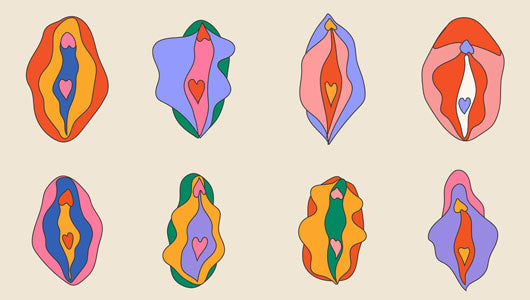
What Is Vaginismus?
If you've ever felt sudden pain when trying to have sex and wondered if you were just too "tight," read on. Dryness and lack of arousal can cause discomfort during penetration, but so can vaginismus. What is vaginismus, and how is it different from other types of pain? Join me as I discuss this fairly common condition, including how it's treated and its surprising connection to the pelvic floor muscles.
What Is Vaginismus?
Vaginismus is characterized by involuntary spasms of the pelvic floor muscles. These spasms can make sex or even putting in a tampon painful or impossible. Vaginismus affects approximately 1-7% of women worldwide.
Symptoms of Vaginismus
Vaginismus symptoms typically appear during late adolescence or early adulthood and can range from a mild or occasional annoyance to severe. More severe vaginismus can disrupt normal sexual activities and make visits to the gynecologist stressful and difficult.
Symptoms of vaginismus include:
- Sudden pain that starts as soon as your try to put something inside your vagina
- Painful muscle spasms in or at the entrance to your vagina
- Burning sensations
- Stinging
You might also notice that you feel urgency when you need to go to the bathroom or aching when you have an orgasm. In rare cases, even exercise or sitting down quickly can trigger spasms.
The pain of vaginismus can cause you to feel anxious and worried about when it might happen again. This can lead to a vicious cycle of pain and a fear of pain that can trigger more spasms, resulting in even more pain.
Involuntary muscle contractions inside the vagina can stop any attempt at penetration, making sex difficult or impossible. You might feel slight discomfort, sharp pain, or even a ripping sensation.
While occasional discomfort during sex can be caused by a lack of arousal, not enough lubrication, or excessive friction from a partner or sex toy, persistent pain should be checked out by a doctor to rule out vaginismus or chronic pain syndromes.
How is Vaginismus Diagnosed?
A gynecologist or urogynecologist is typically best qualified to diagnose vaginal pain, including vaginismus. Your doctor will typically do a pelvic exam and ask about your medical history, including any intercourse pain, urinary tract infections, sexually transmitted infections, or other potential causes of discomfort.
Your doctor may also ask about your mental well-being. Anxiety disorders can sometimes worsen conditions like vaginismus or make them more likely. In some cases, they might recommend further psychiatric evaluation for more insight into how psychological elements may be playing out in relation to your physical symptoms.
Vaginal comfort levels vary from person to person, so be sure to communicate clearly about what you feel during the exam or when you experience painful symptoms.
A doctor's visit can also help rules out other potential causes of pain, including:
Vulvodynia
Vulvodynia causes chronic pain on or inside the vulva. It may or may not involve the muscles of the vaginal opening.
Vestibulodynia
Vestibulodynia is chronic pain at the opening of the vagina in the area called the vestibule. Vestibulodynia is a form of vulvodynia.
Dyspareunia
Dyspareunia refers to painful intercourse, and can be caused by anything from an illness to an infection to vaginal changes related to menopause.
What Causes Vaginismus?
Although anxiety or past trauma can contribute to vaginismus, in most cases the condition is caused by tight, short pelvic floor muscles. These muscles can contract or spasm painfully in pelvis, vagina, or vulva. Pelvic floor muscles can become short and tight from excessive sitting, straining when going to the bathroom, certain kinds of exercise, repeated UTIs, and pregnancy and childbirth.
Pelvic muscles can also tighten in response to chronic anxiety, as well as obesity and poor posture.
How Is Vaginismus Treated?
With the right treatment and support, most people find relief from vaginismus. The goal of any treatment is to improve your symptoms by addressing both the physical and emotional aspects of this condition.
Some of the most common treatments of vaginismus include:
Pelvic floor physical therapy
Working with a pelvic floor physical therapist can help to elongate the pelvic floor muscles and help them regain flexibility. The therapist uses gloved hands to massage and stretch the muscles of the vagina and vaginal opening, allowing them to relax much like the muscles of the back and shoulders during a traditional massage.
Biofeedback
Biofeedback involves the use of sensors placed either externally or internally in the vagina to monitor muscle tension levels during various activities including attempted penetration. Research suggests that biofeedback can help to enhance relaxation strategies, making vaginal entry less painful over time.
Cognitive behavioral therapy (CBT)
Cognitive behavioral therapy can help address anxiety and past trauma that might be related to vaginismus. CBT can also help you deal with the fear of pain that may have developed from the experience of the muscle spasms, as well as the condition's effect on your relationships and sexuality.
Dilators
Silicone or glass dilators allow you to gradually get used to the feeling of penetration and move up in size at your own pace. Dilators are typically used in conjunction with other forms of therapy, and only when the vaginal muscles have been treated enough to admit dilators without extreme pain.
How To Have Sex With Vaginismus
Penetration may not feel possible if you have vaginismus, particularly if you haven’t had treatment or are still in the process of treatment. But you can still enjoy penetration-free solo play and intimacy with your partner. Here are some tips for enjoying pleasure with vaginismus.
Play solo first
If the fear of pain makes you hesitant to get intimate with a partner, take some time on your own to explore what feels good. Not sure where to start? Check out these ideas:
- Use plenty of lube to reduce friction and increase pleasure
- Start by stimulating the outer labia and areas around your labia
- If that feels comfortable, move to the inner labia
- Notice how your body responds. Are you feeling aroused? Do you feel any pain?
- If you don’t feel pain, lightly touch the clitoris
- Pay attention to the signals from your body and respect your limits
The more familiar you become with your body, the more comfortable you can feel communicating what you need and sharing pleasure with a partner.
Learn more: 6 Reasons Why You Should Masturbate
Try toys
If you have trouble feeling pleasure or getting aroused because of the pain of vaginismus, new sensations from toys can inspire you to feel more adventurous and excited. There’s a huge variety of toys designed specifically for clitoral and external stimulation.
Some of my favorite toys for the clitoris and vulva are:
Femme Funn Booster Bullet This toy is compact, flexible, and has low-frequency vibrations, which tend to feel deeper and more pleasurable. It’s also small enough to maneuver in almost any position, and it’s great for travel, too!
Check out my Femme Funn Booster Bullet review
Dame Pom The Pom is a palm-sized vibrator that fits over the vulva and clitoris for broader stimulation. I love its bendable body, super-smooth silicone surface, and gentle lower settings that allow you to build arousal at your own pace.
Learn more about this toy in my Dame Pom review
We-Vibe Melt This air pressure clitoral stimulator is a bestseller for a very good reason. It's ergonomically shaped, has a wide variety of settings, and can be controlled by phone app from anywhere in the world. Customize the vibrations or even sync them with a playlist on your phone.
Le Wand Deux If you find direct clitoral pressure too intense, the Le Wand Deux's split stimulator surrounds the clitoris with pleasurable vibration. This slim, low-profile vibe also features rumbly settings that won't feel overstimulating or buzzy.
Communicate and go slowly
Talk to your partner about what you need and what feels good to you. It can also help to show them how you masturbate and where your (literal) physical limits are. Don’t be afraid to get specific. You might say, “It feels best to touch here,” or “it hurts to touch here.” The more you trust that your partner will respect your limits, the more you can relax and enjoy being intimate with them.
Learn more: How To Talk About Sex
Explore other zones
Pleasure doesn’t stop at the genitals! There are erogenous zones that can help amp up arousal and move intimacy beyond areas that may feel painful or make you anxious. These areas include:
- Behind the ears
- The nape of the neck
- Nipples
- Anal region
- Feet
- Back of the knees
Try exploring these zones with your fingers or mouth, or use toys to pleasure each other in different hot spots. Stimulating other parts of the body is also a great way to build excitement before you move to more intimate areas.
Learn more: How Do I Know If I Had An Orgasm?
